The Cover Artwork of The Children of Arthur Series
Despite the old adage, people always do judge a book by its cover, and so, in publishing The Children of Arthur series, I wanted the books’ covers to reflect the themes and atmosphere of their contents. Many fine graphic artists are out there, but I opted instead to use nineteenth century depictions of legendary figures that fit the individual book titles and which placed me within the literary and Romantic tradition I was modeling. I strongly believe I am trying to capture a somewhat more modern and progressive version of the Arthurian legend akin to what Pre-Raphaelite painters did in their art and nineteenth century authors like Alfred, Lord Tennyson and William Morris captured in their Arthurian poetry. Below is a description of each cover—and how it relates to the series overall.
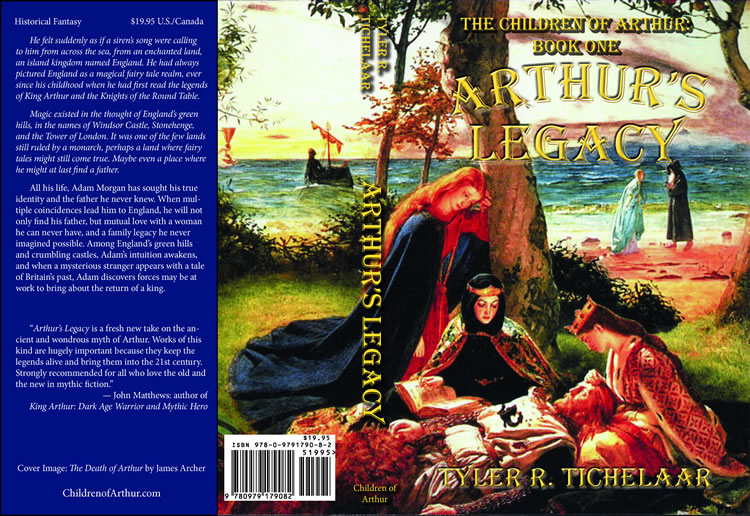
Arthur’s Legacy: The Children of Arthur, Book One
Cover Image: The Death of King Arthur (1860) by James Archer (1822-1904)
For me, no painting is more quintessentially Arthurian than this one, which captures the pivotal moment that transforms Arthur from a king into a legend. This may well be my favorite painting of all time. For me, it captures the great moment of reconciliation in the novel when Arthur has been wounded at Camlann and is about to be carried off to Avalon. Both Morgana and Guinevere come and make their peace with him, and Elaine also comes and makes her peace with Bedwyr, Guinevere’s lover. Of course, as we all know, despite the grief in this scene, Arthur is carried to Avalon to be healed of his wound, and there he resides until the day he will be called upon to return. This moment reminds us that he will return, and hence, his legacy is one of hope and immortality, much like that of Christ, who also plays a role in the novel.
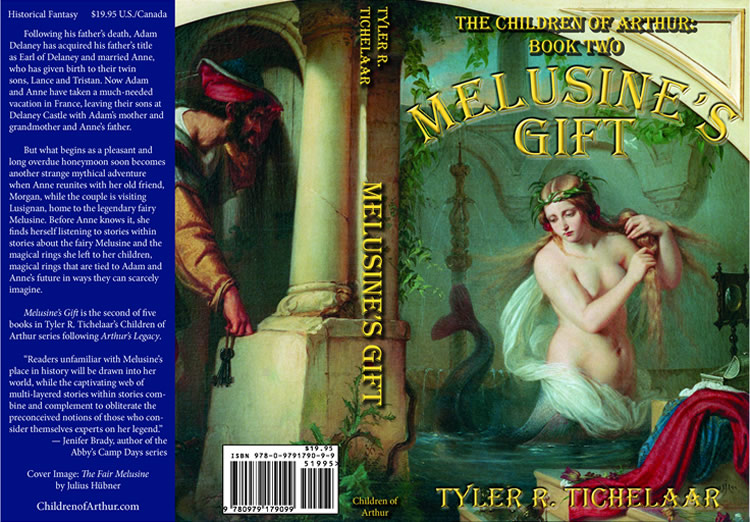
Melusine’s Gift: The Children of Arthur, Book Two
Cover Image: The Fair Melusine (1844) by JuliusHübner (1806-1882)
Many images of Melusine have been painted over the years, but most, being medieval in look, fail to capture the Romantic style, depicting her in unflattering ways largely as a flying serpent. This painting is by a nineteenth century German artist and contemporary of the British Pre-Raphaelites, whose images fill the covers of all the other novels except this one and that of Ogier’s Prayer. To me, this painting was far more beautiful and positive than any other depictions of Melusine. It depicts the magic of Melusine as a mermaid. Some people told me it was too risqué for the cover, so I asked my cover designer to make one small change and move up Melusine’s arm to cover her nipple. Others thought it was creepy that a man is spying on Melusine—he is actually her husband, Raimond. By putting him on the back cover and wrapping the image around the book, I hoped to eliminate the creepiness and only provide the wonder as the first sensation the viewer experiences, and then upon flipping over the book, Raimond can be seen, which adds to the dimension and wonder of the story. This moment is pivotal because Raimond promised Melusine that if she married him, she could hide herself away in private every Saturday and he would not disturb her. When Raimond breaks his promise, Melusine is forced to leave him, but in Melusine’s Gift, I have made that moment not one of shame and curses, but one of wonder and expansion of knowledge. It is only then that Raimond learns what Melusine’s gift truly is.
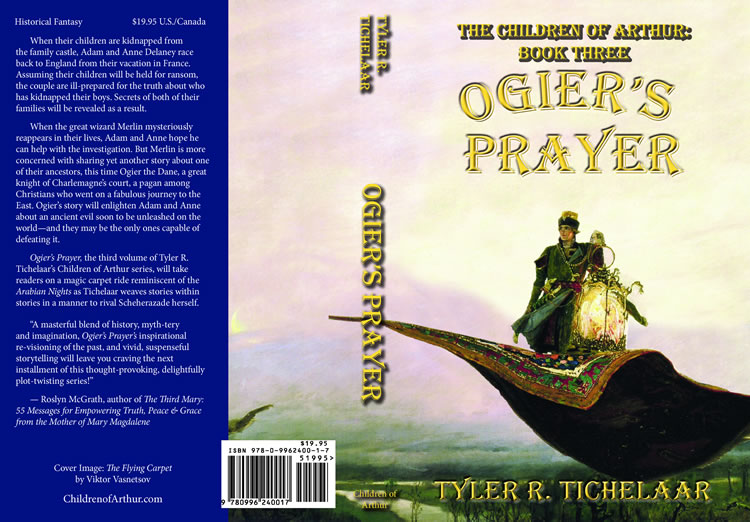
Ogier’s Prayer: The Children of Arthur, Book Three
Cover Image: The Flying Carpet (1880) by Viktor Vasnetsov (1848-1926)
In Ogier’s Prayer, Ogier the Dane, one of Charlemagne’s great knights, is carried on a magic carpet from the fabled land of Prester John to the court of the Caliph Haroun al-Rashid in Baghdad—and you can imagine the reactions of the people of Baghdad when they see him making his entrance in truly grand Arabian Nights style. This painting actually depicts the Russian folklore hero Ivan Tsarevich. However, I felt the scene of Ogier the Dane on a flying carpet was the most visual scene in Ogier’s Prayer so I sought for a flying carpet painting, and when I found this one, I thought it breathtaking. Yes, Ogier would be blonde, not dark-haired, but I imagine his years in the hot Middle East helped to darken his hair and complexion. In the painting, Ivan is carrying a magical firebird with him on the carpet, but if I hadn’t read about the painting, I would have just thought it a lantern, so I thought it close enough for the cover art I desired, and it gave the same feel and matched the Pre-Raphaelite and Romantic style of the other covers.
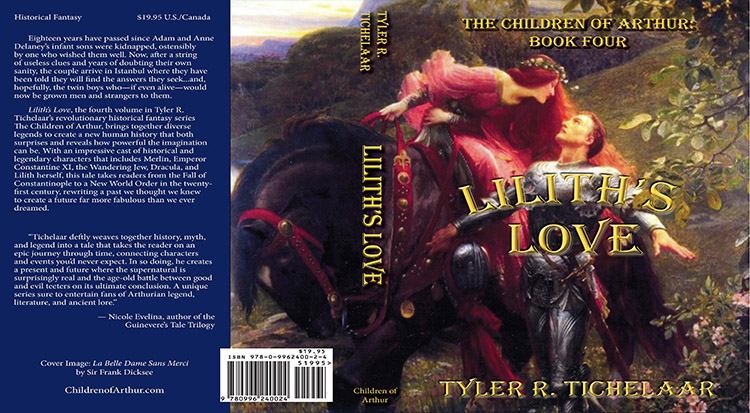
Lilith’s Love: The Children of Arthur, Book Four
Cover Image: La Belle Dame Sans Merci (1902) by Sir Francis Dicksee (1853-1928)
These last two covers are both by Sir Francis Dicksee, one of the best known of the Pre-Raphaelite artists. This first one depicts La Belle Dame Sans Merci, a popular theme of the Pre-Raphaelites. I know of at least two other depictions of her from this period, but this is the most fabulous one. Her name means in French, “The Beautiful Woman Without Mercy,” and she is based upon John Keats’ famous poem of the same name in which a supernatural woman takes a young man for her lover one night, and when he wakes in the morning, he finds that he has spent decades with her and is now an old man. The image was perfect for this book’s cover because Lilith is the primary antagonist of The Children of Arthur series and highly sexual, taking lovers so she can control them. In Jewish tradition, Lilith was the first wife of Adam; she was cast from Eden, and consequently, in The Children of Arthur series, she wants her revenge upon Adam and Eve’s descendants. But she also has a gift to give the world if the world would only quit fighting her—that of love. And so the novel’s title is a play both on the gift of her love and the man she loves. I thought the painting appropriate for the cover because the stunned looking man captures perfectly how the man she takes for her lover in the end must feel—and yes, he turns out to be a true and chivalrous knight.
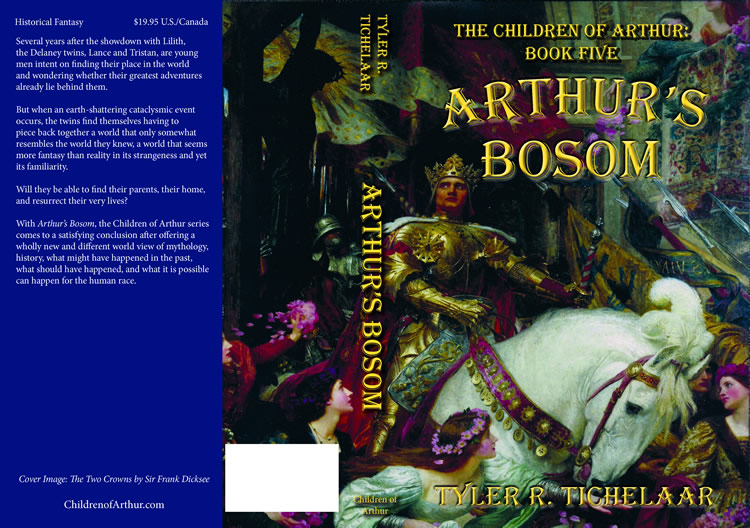
Arthur’s Bosom: The Children of Arthur, Book Five
Cover Image: The Two Crowns (1900) by Sir Francis Dicksee (1853-1928)
I had the most difficulty in finding an image for this final book in the series, largely because I had only started to draft the novel at the time so I didn’t have a full idea of what it would be about yet. Then one day I stumbled upon this painting and knew it was perfect. This final novel depicts the return of King Arthur, and so what better to have on the cover than a king? It wasn’t until I saw the painting’s name that I even spotted there were two crowns in it—yes, the second is Christ with his crown of thorns. As with the cover for Melusine’s Gift, I decided to wrap the image so the back would surprise readers. In doing so, I had to have the image reversed since, originally, Christ was on the right side, and I wanted him on the back of the book. Only when you turn the book over then do you see that the king is looking at Christ and, therefore, is meditating upon what a true king is and what it means to wear a crown. It felt like it was destiny that I would find this painting, for at the same time, I first heard the theories of how Christ’s cross was brought back to Britain by the Empress Helena, and so that story and this painting with its depiction of Christ on the cross really inspired the writing of the novel. In the novel, my main character goes upon a quest to find the True Cross and by doing so, he helps to bring about King Arthur’s return. As for the book’s title, it refers to a line in Shakespeare, a play on the biblical phrase of “Abraham’s Bosom,” which is a reference to heaven. In the novel, the main character finds himself in what might be termed a type of Arthurian heaven.

I hope my choice of cover images inspires my readers and complements the primary theme of the Children of Arthur series, which is:
Imagination is the Salvation of Mankind.
May these books and their covers lead you on your own fabulously imaginative and world-changing journey!
|



